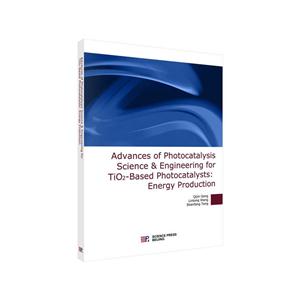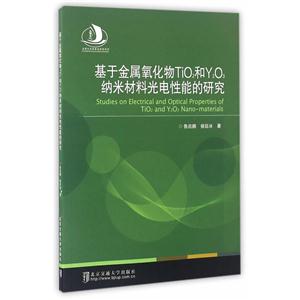
作者:耿启金等著
页数:293页
出版社:科学出版社
出版日期:2016
ISBN:9787030498304
电子书格式:pdf/epub/txt
内容简介
自19世纪70年代发现了半导体材料光催化裂解水的现象以来,光催化氧化技术得到迅速发展。光催化技术具有催化材料易得,运行成本低,可利用太阳光作为光源等优点,是一种具有巨大潜在应用价值的污染治理技术。常用的金属氧化物光催化剂有:Fe2O3、WO3、Cr2O3、ZnO、ZrO、TiO2等。其中TiO2来源广、化学稳定性和催化活性高,无毒性,成为研究中使用广泛的光催化剂之一,光催化是基于光激发半导体材料而产生的电子-空穴对,激发的电子和空穴迁移到半导体颗粒表面;如果能带边缘(bandedge)位置符合某种要求时,光生电子和空穴就会与吸附水或有机物发生氧化还原反应,从而实现光催化作用。本书针对光催化剂的发展和在能源领域的应用研究,做了系统总结和整理,概括为以下几个内容:(1)光催化科学的发展进程;(2)光催化剂的制备与修饰进展;(3)光催化技术在制氢方面的研究进展;(4)光催化技术在CO2能源转化方面的研究进展。
作者简介
耿启金,Qijin Geng, Ph.D, Associate Professor of College of Chemistry-Chemical & Environmental Engineering, Weifang University. The membership in Chemistry Association of China. Add: College of Chemistry and Chemical Engineering, Weifang University, Shandong Province, 261061, P. R. China. Qijin Geng was born in China in December, 1969. He gained lus bachelor degree from College of Textile Chemical Engineering in Qingdao University in 1992. The master degree of applied chemistry was obtained in Jinan University in 2004 and Ph. D degree of chemical engineering at Qingdao University of Science and Technology, Shandong Province, P. R. China in 2011. The speciality is photocatalytic decomposition of waste water and gaseous pollutants, building materials, nano-sized material preparation, and multi-phase fluidization reaction engineering. He has published about 50 academic paper in chemical engineering and environmental science joumal, such as Industrial & Engineering Chenustry Research (IEC), Environmental Technology (TENT), Chemical Engineering & Technology (CET), Research on Chemical Intermediates (Res. Chem. Intermed.), New Building Material (NBM) and Biomedical and Environmental Science (BES), et al. Consequently, he was invited by some journals as a reviewer, such as Journal of Environmental Management, Research on Chemical Intermediates, Separation Science and Technology, Joumal of Chemical Technology & Biotechnology, International Research Journals of Biochemistry and Bioinformatics, Chemical Engineering Journal, Journal of Environmental Sciences, Environmental Science and Pollution Research, etc.
目录
Foreword1 Structure and Properties of TiO2-based Photocatalyst1.1 Structure1.1.1 Crystal structures1.1.2 Surface structure1.2 Properties1.2.1 Oxidation and reduction sites1.2.2 Electronic properties1.2.3 Electrochemical properties1.2.4 Photoelectrochemical properties1.2.5 Surface adsorption properties1.2.6 Surface chemistry properties1.2.7 Photon absorption properties1.2.8 Photo-induced superhydrophilicity1.3 Summary2 Synthesizing Methods and Fabrication of TiO2-based Photocatalyst2.1 Basic synthesis methods2.1.1 Sol-gel method2.1.2 Hydrothermal method2.1.3 Solvothermal method2.1.4 Anodic oxidation method2.1.5 Microwave-assisted method2.1.6 Hard template method2.1.7 Reverse microemulsion method2.1.8 Direct oxidation method2.1.9 Non-hydrolytic sol-gel method2.1.10 Sonochemical method2.1.11 Chemical vapor deposition2.1.12 Physical vapor deposition2.1.13 Electrodeposition method2.1.14 Ionic liquid-assisted method2.2 Factors influencing the formation of titanate nanotubes via hydrothermal treatment2.2.1 Starting materials: phases and particle sizes2.2.2 Alkaline solution: types and concentrations2.2.3 Hydrothermal treatment: temperature and duration2.2.4 Assisted hydrothermal synthesis2.2.5 Post-hydrothermal treatments2.3 Summary3 Modification Techniques of TiO2-based Photocatalysts3.1 Basic ideas of modification3.1.1 Morphological variation3.1.2 Band gap modification by creation of oxygen vacancies and oxygen sub-stoichiometry3.1.3 Spatially structured and chemically modified visible light active titania3.2 Modification technology3.2.1 Metal-loaded TiO23.2.2 Doped TiO23.2.3 Co-doped TiO23.2.4 Semiconductors coupled TiO23.2.5 Dye sensitized TiO23.2.6 Support ofphotocatalyst3.3 Conclusions4 Hydrogen Production in Heterogeneous Photocatalysis4.1 Basic principles of photocatalytic hydrogen generation4.1.1 Mechanism of photocatalytic hydrogen generation for PEC4.1.2 Mechanism of H2S photolysis in the liquid phase4.1.3 Mechanism of water splitting employing dye-sensitized solar ceils to harvest visible light4.1.4 Main processes ofphotocatalytic hydrogen generation4.1.5 Types of reactions4.2 Evaluation ofphotocatalytic water splitting4.2.1 Photocatalytic activity4.2.2 Photocatalytic stability4.2.3 Evaluation of PEC performance4.3 Development of photocatalytic system for hydrogen production4.3.1 PEC water splitting system4.3.2 Photocatalytic hydrogen generation in batch systems under visible light irradiation4.3.3 Photocatalytic hydrogen generation in membrane systems4.3.4 Liquid-phase photocatalytic reactor using H2S4.3.5 Gas-phase photocatalytic reactor for H2S4.4 Recent progress ofphotocatalytic water splitting for hydrogen production4.4.1 Co-catalyst4.4.2 Doped with metals4.5 Main factors influencing photocatalytic hydrogen production4.5.1 Structure and morphology/crystallinity of catalyst4.5.2 Bandgap energy4.5.3 Corrosion resistance4.5.4 Sacrificial agent/electron donor in water solution4.5.5 Operating temperature4.5.6 Light intensity4.5.7 Solution pH value4.6 Main challenges, opportunities and outlook
5 Heterogeneous Photocatalytic Reduction of CO2 to Fuels5.1 Advances of CO2 photocatalytic reduction5.2 Fundamentals of CO2 photocatalytic conversion5.2.1 Basic mechanism5.2.2 Photoexcitation and recombination5.2.3 Chemical transformation5.2.4 Selectivity in the photocatalytic CO2 reduction5.2.5 Thermodynamic analysis5.3 TiO2-based photocatalysts for CO2 photoconversion5.3.1 Physical and photocatalytic reduction properties of TiO2-based photocatalysts5.3.2 Advances in visible light responsive TiO2-based photocatalysts5.3.3 Support materials for catalyst immobilization5.3.4 Highly dispersed TiO2 photocatalysts5.4 Reductants5.5 Operation parameters influencing on CO2 reduction5.6 Photocatalytic reactors and prospects5.6.1 Anode oxidation and cathode reduction compartments5.6.2 Photocatalytic reduction reactors5.7 Future prospects for sustainable phototechnologyMain References
下载地址
立即下载(解压密码:www.teccses.org)
Article Title:《TiO2基光催化在能源领域的研究进展(英文)》
Article link:
https://www.teccses.org/732178.html















